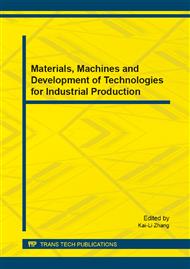[1]
R.E. Taylor, X. Wang, X. Xu, Thermophysical properties of thermal barrier coatings, Surf. Coat. Technol. 120(1999) 89-95.
Google Scholar
[2]
S. Gu, T.J. Lu, D.D. Hass, Thermal conductivity of zirconia coatings with zig-zag pore microstructures, Acta. Mater. 49 (2001) 2539-2547.
DOI: 10.1016/s1359-6454(01)00141-0
Google Scholar
[3]
C.H. Hsurh, J.A. Haynes, M.J. Lance, Effects of interface roughness on residual stresses in thermal barrier coatings, Am. Ceram. Soc. 82 (1999) 1073-1075.
Google Scholar
[4]
H.X. Chen, K.S. Zhou, Z.P. Jin, Study of failure mechanisms of thermal barrier coatings by plasma spraying, J. Nono. Met. 12 (2002) 116-119.
Google Scholar
[5]
B.H. Kear, G. Skandan, Thermal spray processing of nanoscale materials, Nanostruct. Mater. 8 (1997) 765-769.
DOI: 10.1016/s0965-9773(97)00226-2
Google Scholar
[6]
Z. X Ding, Research status of thermal barrier coatings and application, Surf. Eng. 43 (1999) 31-37.
Google Scholar
[7]
Z.L. Dong, K.A. Khor, Y.W. Gu, Microstructure formation in plasma-sprayed functionally graded NiCoCrAlY/yttria-stabilized zirconia coatings, Surf. Coat. Technol. 114 (1999) 181-186.
DOI: 10.1016/s0257-8972(99)00049-3
Google Scholar
[8]
S.Y. Joshi, M.P. Srivastara, Life time determining factors during thermal cycling of zirconia based thermal barrier coatings, Surf. Eng. 11(1995) 233-239.
DOI: 10.1179/sur.1995.11.3.233
Google Scholar
[9]
M. Gell, E.H. Jordan, Y.H. Sohn, Development and implementation of plasma sprayed nanostructured ceramic coatings, Surf. Coat. Technol. 146 (2001) 48-54.
DOI: 10.1016/s0257-8972(01)01470-0
Google Scholar
[10]
R.S. Lima, A. Kucuk, C.C. Berndt, Integrity of nanostructured partially stabilized zirconia after plasma spray processing, Mater. Sci. Eng. 313 (2001) 75-82.
DOI: 10.1016/s0921-5093(01)01146-7
Google Scholar
[11]
U. Ozer, E.M. Terrence, H.H. Arthur, Microstructures of Y2O3-stabilized ZrO2 electron beam-physical vapor deposition coating on Ni-base superalloys, Am. Ceram. Soc. 77 (1994) 984-992.
DOI: 10.1111/j.1151-2916.1994.tb07256.x
Google Scholar


